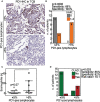PD-1 expression in transbronchial biopsies of lung transplant recipients is a possible early predictor of rejection
- PMID: 36703976
- PMCID: PMC9871480
- DOI: 10.3389/fimmu.2022.1024021
PD-1 expression in transbronchial biopsies of lung transplant recipients is a possible early predictor of rejection
Abstract
Introduction: Chronic lung allograft dysfunction (CLAD) is the main cause of the reduced survival of lung transplanted (LTx) patients. The possible role of immune checkpoint molecules in establishing tolerance has been scarcely investigated in the setting of lung transplantation.
Methods: We conducted a retrospective, observational pilot study on a consecutive series of transbronchial cryobiopsies (TCB) obtained from 24 patients during LTx follow-up focusing on PD-1, one of the most investigated immune checkpoint molecules.
Results: Results showed that PD-1-expressing T lymphocytes were present in all TCB with a histological diagnosis of acute rejection (AR; 9/9), but not in most (11/15) of the TCB not resulting in a diagnosis of AR (p=0.0006). Notably, the presence of PD-1-expressing T lymphocytes in TCB resulted in a 10-times higher risk of developing chronic lung allograft dysfunction (CLAD), the main cause of the reduced survival of lung transplanted patients, thus being associated with a clearly worst clinical outcome.
Discussion: Results of this pilot study indicate a central role of PD-1 in the development of AR and its evolution towards CLAD and suggest that the evaluation of PD-1-expressing lymphocytes in TCB could offer a prognostic advantage in monitoring the onset of AR in patients who underwent lung transplantation.
Keywords: PD-1; chronic rejection; immune checkpoint molecules; immunology; lung transplantation.
Copyright © 2023 Righi, Vaira, Morlacchi, Croci, Rossetti, Blasi, Ferrero, Nosotti, Rosso and Clerici.
Conflict of interest statement
The authors declare that the research was conducted in the absence of any commercial or financial relationships that could be construed as a potential conflict of interest.
Figures


Similar articles
-
Immune Checkpoints Expression in Chronic Lung Allograft Rejection.Front Immunol. 2021 Aug 13;12:714132. doi: 10.3389/fimmu.2021.714132. eCollection 2021. Front Immunol. 2021. PMID: 34489963 Free PMC article.
-
Impact of Allograft Injury Time of Onset on the Development of Chronic Lung Allograft Dysfunction After Lung Transplantation.Am J Transplant. 2017 May;17(5):1294-1303. doi: 10.1111/ajt.14066. Epub 2016 Oct 31. Am J Transplant. 2017. PMID: 27676455 Free PMC article. Clinical Trial.
-
Transbronchial Cryobiopsies in Lung Allograft Recipients for Surveillance Purposes: Initial Results.Transplant Proc. 2020 Jun;52(5):1601-1604. doi: 10.1016/j.transproceed.2020.02.052. Epub 2020 Mar 26. Transplant Proc. 2020. PMID: 32224013
-
Long-term outcomes and management of lung transplant recipients.Best Pract Res Clin Anaesthesiol. 2017 Jun;31(2):285-297. doi: 10.1016/j.bpa.2017.05.006. Epub 2017 May 30. Best Pract Res Clin Anaesthesiol. 2017. PMID: 29110800 Review.
-
Emerging biomarkers in chronic lung allograft dysfunction.Expert Rev Mol Diagn. 2020 May;20(5):467-475. doi: 10.1080/14737159.2020.1738929. Epub 2020 Mar 12. Expert Rev Mol Diagn. 2020. PMID: 32133875 Review.
Cited by
-
Elevated PD-L1 and PECAM-1 as Diagnostic Biomarkers of Acute Rejection in Lung Transplantation.Transpl Int. 2024 Nov 21;37:13796. doi: 10.3389/ti.2024.13796. eCollection 2024. Transpl Int. 2024. PMID: 39640249 Free PMC article.
References
-
- Koutsokera A, Royer PJ, Antonietti JP, Fritz A, Benden C, Aubert JD, et al. . Development of a multivariate prediction model for early-onset bronchiolitis obliterans syndrome and restrictive allograft syndrome in lung transplantation. Front Med (2017) 4:109. doi: 10.3389/fmed.2017.00109 - DOI - PMC - PubMed
-
- Glanville AR, Verleden GM, Todd JL, Benden C, Calabrese F, Gottlieb J, et al. . Chronic lung allograft dysfunction: Definition and update of restrictive allograft syndrome-a consensus report from the pulmonary council of the ISHLT. J Heart Lung Transplant (2019) 38(5):483–92. doi: 10.1016/j.healun.2019.03.008 - DOI - PubMed
Publication types
MeSH terms
Substances
LinkOut - more resources
Full Text Sources
Medical
Research Materials

